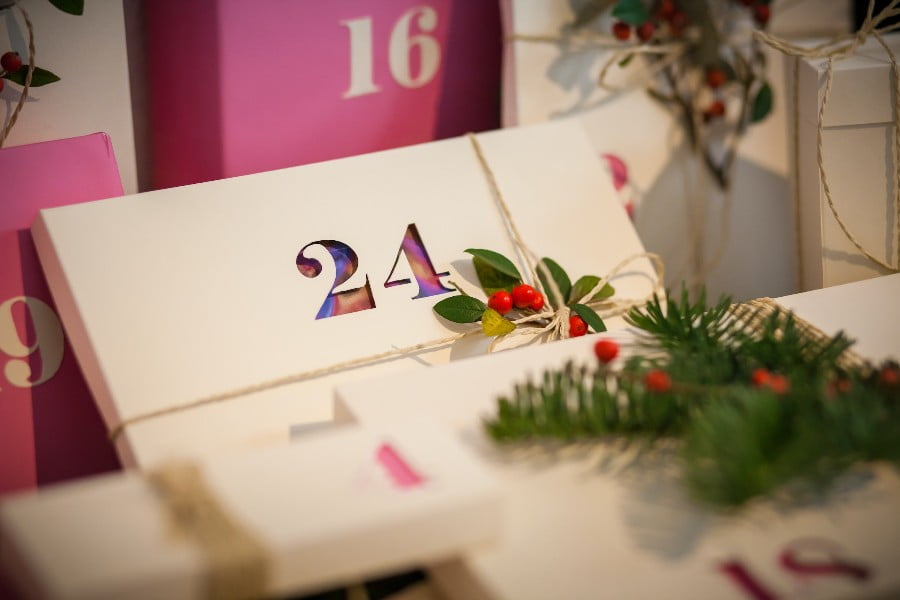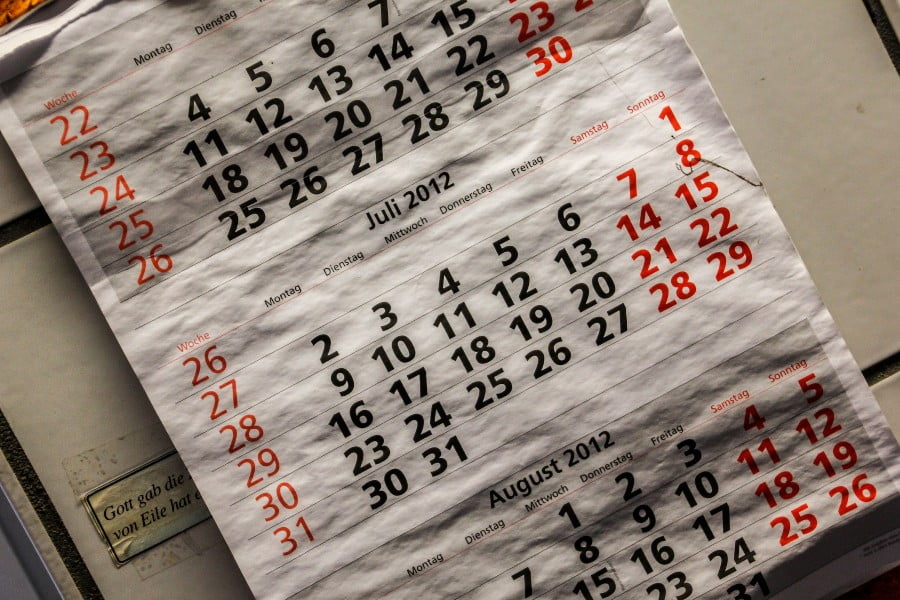The movement of the moon and sun was utilized to keep time in ancient times. With time, these methods were improved to produce Calendar, a more organized tool. Everywhere in the world, people use calendars as a way to keep track of the days, weeks, months, and years. Continue reading to learn 20 intriguing facts about calendars.
20 Intriguing Facts about Calendars
1. The term ‘Calendar’ is taken from a Latin word

The word is derived from calendae (or kalendae), the first day of the month in the Roman republican calendar, which was the day on which future market days, feasts, and other occasions were declared. Calendae is the Latin word for “interest register” or “account book.”
2. The Julian Calendar’s mistake caused it to move past the actual solar calendar

The astronomer Sosigenes was tasked by Julius Caesar with creating a calendar. The resulting calendar has 365 days with 30 to 31 days per month. Every fourth year there was a leap year on the Julian calendar. Due to this small inaccuracy, the calendar skipped ahead of the solar calendar and did not accurately reflect how long it takes the Earth to complete one orbit of the Sun. This mistake was addressed by the Gregorian calendar. With the exception of century years that aren’t equally divisible by four, we continue to add a leap year every fourth year.
3. Pope Gregory asked Jesuit astronomer and mathematician Christoph Kleu to amend the Julian calendar

Aloysius Lilius, a physician, and Christopher Clavius, an astronomer, were chosen by Pope Gregory XIII in 1577 to address the issue of the Julian calendar’s 10-day discrepancy with the solar year. The two came up with a solution in 1582, five years after discovering and solving the issue, which ultimately resulted in the creation of the Gregorian Calendar.
4. The number of average days is the main distinction between the Julian and Gregorian calendars

The Julian calendar has 365.25 days, whereas the Gregorian calendar has 365.2425.
5. The Gregorian calendar was first adopted by Catholic nations

It took more than three centuries for the Gregorian calendar to become the accepted global standard. The Catholic countries of Spain, Portugal, and Italy were the first to adopt the Gregorian calendar. Other Catholic nations soon followed, but Protestant nations resisted change, and Greek orthodox nations didn’t shift until the turn of the 20th century.
6. England and Italy did not make January 1 the formal start of the year until 1750

Pope Gregory XIII introduced a new calendar in 1582 to replace the one established by Julius Caesar in 45 BC. One of the primary causes of the January 1st dispute was England’s refusal to obey the pope after Henry VIII broke with Rome in the 1530s.
7. In Sweden, there was once a 40-year attempt to eliminate leap days

Sweden, which at the time encompassed Finland, planned to switch from the Julian to the Gregorian calendar in 1700. As a result, Sweden did not experience a leap year in 1700, which according to the Julian calendar should have occurred. But unintentionally, 1704 and 1708 started off as leap years.
Sweden reverted to using the Julian calendar as a result of being out of sync with both the Julian and Gregorian calendars. When the Julian calendar was reinstated in Sweden in 1712 and two extra leap days were added, February 30 became a legal holiday. Sweden made its ultimate transition to the Gregorian calendar in 1753, when an 11-day correction was made so that March 1 of that year came after February 17. The calendar change did not please everyone. Some others felt their life had been stolen for 11 days.
8. The Gregorian calendar followed the seven-day week norm established by the Babylonian calendar

This ancient society, who lived in Mesopotamia in what is now Iraq, rounded the Moon cycle down to 28 days and divided this time span into 4 periods of 7 days each, using leap days to stay in sync with the Moon phases in the long run. This 7-day structure is also believed to have ultimately informed a number of popular creation myths, such as the Book of Genesis in the Hebrew and Christian Bibles, which states that God created the world in seven days: six days of work followed by one day of rest.
9. The Gregorian calendar maintained the Julian calendar’s months

The names of the months have their roots in Latin words, historical persons, and Roman deities. The Roman god Janus is honoured with the name January. The Roman festival of Februa, which was a time of cleansing, inspired the name of the month of February. The month of March is named for Mars, the Roman god of war.
The start of the Roman calendar is in March. However, the word “April” comes from the Latin verb “aperire,” which means to open. While June is named after Juno, the Roman goddess of marriage and childbirth, May is named after the Greek goddess Maia. The two primary Roman emperors, Julius and Augustus, are referred to as July and August. As they were initially in the Roman calendar, September, October, November, and December are referred to as the Roman numbers 7, 8, 9, and 10.
10. According to legend, Emperor Huangdi created the Chinese calendar in 2637 BCE

The traditional Chinese calendar is known as the lunisolar calendar, which is a lunar calendar, and the years are named after Zodiac animals. Days were initially added to the lunar year in order to maintain a similar relationship between them and the seasons.
Read also – 21 Fascinating Facts about Pisces
11. The lunisolar calendar was the most widely used pre-modern calendar

The early civilizations of the whole Middle East, with the exception of Egypt, and Greece employed the lunisolar calendar, in which the months are lunar but the years are solar—that is, they are brought into alignment with the course of the Sun.
12. The Muslim calendar follows the lunar cycle as well

The Islamic calendar, commonly known as the Hijri calendar or the Muslim calendar, is a calendar used for religious purposes in the Islamic world. Its foundation is a year with 12 months. Every month starts around the time of the new moon. Except for the 12th, Dh al-ijjah, which has a different length every 30 years in order to maintain the calendar in sync with the actual phases of the moon, the months are alternately 30 and 29 days long. As a result, the year either has 354 or 355 days.
13. The Mayans used three calendars

The Long Count, the Tzolkin (divine calendar), and the Haab are three separate dating systems used concurrently by the Maya (civil calendar). Only the Haab of these is directly related to the duration of the year.
14. The Egyptians are to be credited with inferring the solar year

They even authorised a calendar that included an extra day that would pressure after four years. Caesar is thought to have learned about this concept after Cleopatra explained the system to him.
15. The Persian calendar or Iranian calendar is based on observation

It is based on observation rather than rules and is more accurate than the Gregorian calendar.
16. The Sumerians, who lived in Mesopotamia during the Bronze Age, created the first calendar

During the Bronze Age, the Sumerians were the first people in Mesopotamia to adopt calendars. Depending on whether or not the opening day featured a full moon, each month on this calendar had either 29 or 30 days. There were always 12 months in a year.
17. In order to keep track of years for his Easter table, monk Dionysius Exiguus created the Anno Domini system in 525

Since that time, the Julian and Gregorian calendars have both used the words Anno Domini and Before Christ when referring to the years.
18. The seven-day week was established by Emperor Constantine, with Sunday being the first day in the Roman calendar

For many years, the Romans observed an eight-day civil week, but in 321 CE, Emperor Constantine changed Roman civil law to recognise a seven-day week, with Sunday as the first day. Christian convert Constantine established Sunday as a day of rest and worship.
19. The Saxons are credited for the names of the days of the week.

The days of the week were given god names by the Saxons. “Sun’s Day” fell on Sunday. The moon inspired the name Monday. Wednesday was “Woden’s Day,” while Tuesday was “Tiw’s Day.” Thor’s Day was celebrated on Thursday, while “Frigg’s Day” was observed on Friday. Saturn was the god for whom Saturday was named.
20. September 1 marked the start of the year for the Byzantine Empire.

Instead of counting the years since Christ’s birth, they used a different date for the creation of the world: 1 September 5509 B.C.E.
Calendars have evolved during different time periods and in different civilizations to accommodate various human needs be that religious like festivals or scientific like leap years. This evolution of calendars paints a fascinating tale of how the human brain has evolved to become a multi-faceted being.
Read also – 20 Compelling Facts about Libra